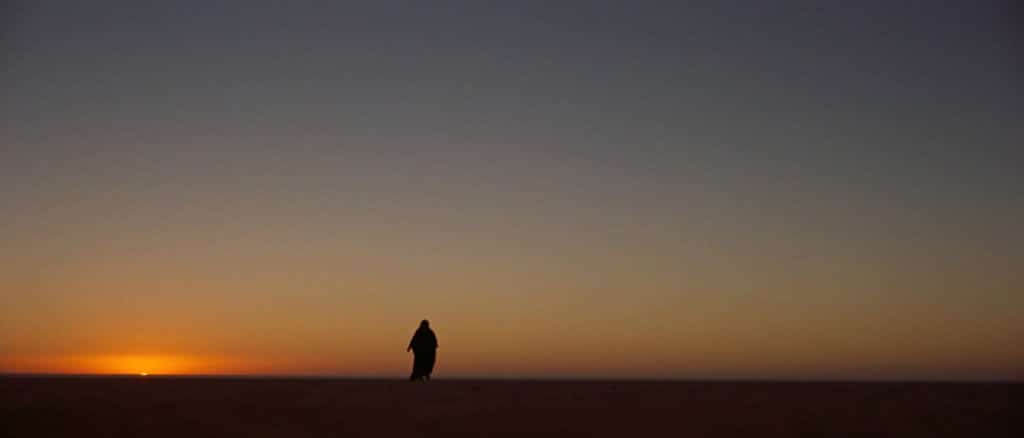
Welcome to Back to the Movies, a special series of articles in which we’re exploring how we feel about returning to movie theaters after the pandemic. For this entry, Aurora Amidon celebrates the experience of watching movies projected on film.
When I was a freshman in college, I had my first non-digital movie-watching experience. My school’s film department rented a 70mm print of David Lean’s Lawrence of Arabia, and although I was excited to see Omar Sharif’s face in such dazzling perimeters, I had never considered watching something on film to be a particularly special event.
I had seen Lawrence of Arabia before — in the living room of my childhood home on a flat-screen television with my parents — but this time it was different. Forty-five minutes into the film, Peter O’Toole as T.E. Lawrence holds a match to his face, watches it flicker, and then blows it out. The match then metamorphoses into the sun rising slowly over the flat sands of Arabia and ignites the sky in a brilliant red.
But it wasn’t the red I was used to seeing. It was a red that, for a fleeting moment, I believed I could reach out and touch. For two-hundred-and-twenty-eight minutes and nineteen thousand and nine-hundred and ninety feet of film, I was completely transported to the rugged sands of the Nefud desert as I sat in that dark theater. For days after the screening, the colors and textures of the film played over and over in my head. I was hooked, but I did not yet understand why.
For better or worse, that lack of understanding is part of the authenticity of film — and likely its appeal, too. On a basic level, color is more dazzling on film, lines more elegant. This inexplicable allure has some scientific backing. When a roll of film is spooled through a projector, it catches the light through the film, which is projected again through the light. With digital images, the light is simply being run through a computer. Perhaps it is easier to explain what happens when an image runs through a computer, and the enigma of film is part of what draws that to us.
But how much of the appeal is technological, and how much is psychological? This can be analyzed from these two different standpoints. Color film generally brings forth more vibrant colors than digital. Because of this, the image is pleasing to watch because we are evolutionarily programmed to pay attention to bright colors, as they signify predators and poisonous things. We stay alert when watching film and are thus predisposed to feel more connected to it. In addition, the gentle outlines are easier on the eyes than what are primarily cold outlines of digital pictures, so it is not a strain to watch.
For me, film is pleasing largely on a psychological basis. Film is personal. The splicing of images reminds us of photographs. In fact, the inception of film was based on a love of photography. In 1888, French inventor Louis Le Prince’s Roundhay Garden Scene sprang from Le Prince’s longing for animated photos. If watched closely, the thirteen-second film is just that: an animation; a series of photos shot on a single lens combi camera-projector, which is a camera that allows long enough exposures and light sensitivity to give photographs the illusion of movement, along with an ability to take photos in rapid succession with one lens and a single roll of film.
The tactile element of film is important. Film is something to hold in your hand, to spool and unspool, to cut and bind back together. For many of us, this fact subconsciously reminds us of home videos from when we were little. Perhaps our parents and grandparents have stories told lovingly about watching film premieres in the cinema.
Ever since internet-based companies such as Netflix, Amazon, and Hulu rose in popularity, it has been difficult to predict the place film has in the future. People are drawn to these distributors primarily because of their convenience, and film is anything but convenient. From a standpoint of projecting it, a shutter has to manually rotate twenty-four times per second, making sure to obscure the lamp with the blade while the frames are in the process of changing. And from a filmmaking standpoint, it’s even more arduous, risky, and expensive.
So it stands to reason that, after a year of theaters being shut down, it is difficult to say whether people will be returning to normal theaters, let alone the few theaters that give the option of watching movies on film.
But there has always been a market for watching reels of film spool through a projector, and the optimist in me says there always will be. The fact that people are drawn to the medium even in its waning popularity and necessity gives me hope for the future. During the pandemic, movie theaters were sorely missed. People mourned the closing of their favorite venues, and they tried to recreate the experience of sitting in a cinema at home, which is something they were somewhat able to do. But recreating the experience of watching something on film is significantly more difficult.
Some people think that the pandemic will make going to the movies a lost pastime. I don’t agree. If you remember what it was like to watch T.E. Lawrence blow out a match in 70mm, you’ll know that when people talk about “getting back to life,” that’s what they mean.
Article From & Read More ( Back to the Movies: Projected on Film - Film School Rejects )https://ift.tt/3i0rlBQ
Film
Bagikan Berita Ini














0 Response to "Back to the Movies: Projected on Film - Film School Rejects"
Post a Comment